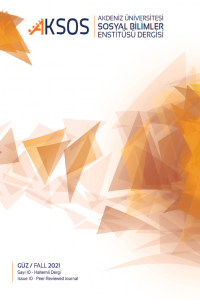Abstract
Bu makalenin amacı Peter Barnes’ın The Ruling Class (1968) adlı oyununu modern Menippos hicvi örneği olarak incelemektir. Menippos hicvinin tanımı değişken yapısından dolayı zordur. En basit tanımıyla, Menippos hicvi düz yazı ve nazmın karışımıdır. Ayrıca, bu tür hiciv karnivalesk bir atmosfer yaratarak normlarla, kültürel, dini ya da felsefik doktrinlerle ilgili kesin yargıları reddeder. Bu kesin yargıları reddederken Menippos hicvi parodi, ironi, metinlararasılık, normalde bir arada olamayacak şeylerin yan yana getirilmesi, fantastic öğeler ve, delilik ve düş kurma gibi her türlü psikolojik anormallikleri içeren teknikler kullanır ve tüm bu teknikler aynı zamanda oyunların karnivalesk niteliklerini artırır. Menippos hicvi eserlerin sonunda herhangi bir çözüm önermez çünkü herhangi bir ideolojiyi diğerine üstün göstermek yerine tüm ideolojilerin yanlış ve uygulamalarının bozuk olduğunu gösterir. Menippos hicvinin tüm özellikleri Barnes’ın adı geçen oyununda bulunmaktadır. Böylece makale the Ruling class adlı oyunun Menippos hicvinin bir örneği olarak sınıflandırılabileceğini göstermektedir.
References
- Bakhtin, M. M. (1984). Rabelais and His World. Trans. Helen Iswolsky. Bloomington: Indiana UP.
- ---. The Problems of Dostoevsky’s Poetics. Trans. Caryl Emerson. London: University of Minnesota Press, 1999.
- Barnes, P. (1996). Peter Barnes Plays: 1, The Ruling Class. London: Heinemann Educational Ltd.
- Bartie, A. (2013). The Edinburgh Festivals : Culture and Society in Postwar Britain. Edinburgh University Press, 2013. EBSCOhost.
- Childs, D. (1995). Britain Since 1939, Progress and Decline. London: Macmillan Press LTD. Hennessy, B. (1970-71 Winter). “Peter Barnes: Interviewed by BRENDAN HENNESSY”. The Transatlantic Review, No. 37/38, pp. 118-124.
- Kirk, E. (1980). Menippean Satire: An Annotated Catalogue of Texts and Criticism. New York: Garland Publishing.
- Lomas, C. (2009). “Sir Alec Doulas home: A Case Study in Rhetorical Failure”. Quarterly Journal of Speech, 56:3, 296-303. Web: 18 April, 2018.
- Milowicki, E. and Robert Rawdon Wilson. (2002). “A Measure for Menippean Discourse: The Example of Shakespeare”.Poetics Today 23:2, pp.291-326.
- Nicholson, S. (2014). The Censorship of British Drama 1900-1968: Volume One 1900- 1932. University of Exeter Press, 2014. The Censorship of British Drama, 1900-1968. EBSCOhost.
- Relihan, J. (1993). Ancient Menippean Satire. Baltimore: The Johns Hopkins University Press.
- Shakespeare, W. (1960) William Shakespeare The Complete Works. London: Collins Clear-Type Press. Ruskin, J. (1907). The Crown of Wild Olive. London: Ballantyne, Hanson Co.
- Weinbrot, H. (1965). “The Pattern of Formal Verse Satire in the Restoration and the Eighteenth Century”. PMLA, Vol. 80, No. 4, pp. 394-401.
Abstract
The aim of this paper is to study Peter Barnes’ play, The Ruling Class (1968) as an example of modern Menippean satire. Menippean satire is difficult to define because of its protean structure. Menippean satire is a mingling of prose and poetry in its simplest sense. In addition, it always desires to reject any sort of absolutes regarding norms, cultural, religious or philosophical dogmas by creating a carnivalesque atmosphere. In order to oppose absolutes, Menippean satire makes use of parody, irony, intertextuality, juxtapositions of normally incompatible things, any sort of psychological abnormalities such as madness and daydreaming, all of which enhance the carnivalesque quality of the plays. Menippean satire does not offer a resolution at the end of the workss because the genre does not favor any ideology over another but shows all of them as faulty and corrupted. The paper will conclude that all the features of Menippean satire are found in Barnes’ above-mentioned play; thus, the play may be considered as an example of modern Menippean satire.
References
- Bakhtin, M. M. (1984). Rabelais and His World. Trans. Helen Iswolsky. Bloomington: Indiana UP.
- ---. The Problems of Dostoevsky’s Poetics. Trans. Caryl Emerson. London: University of Minnesota Press, 1999.
- Barnes, P. (1996). Peter Barnes Plays: 1, The Ruling Class. London: Heinemann Educational Ltd.
- Bartie, A. (2013). The Edinburgh Festivals : Culture and Society in Postwar Britain. Edinburgh University Press, 2013. EBSCOhost.
- Childs, D. (1995). Britain Since 1939, Progress and Decline. London: Macmillan Press LTD. Hennessy, B. (1970-71 Winter). “Peter Barnes: Interviewed by BRENDAN HENNESSY”. The Transatlantic Review, No. 37/38, pp. 118-124.
- Kirk, E. (1980). Menippean Satire: An Annotated Catalogue of Texts and Criticism. New York: Garland Publishing.
- Lomas, C. (2009). “Sir Alec Doulas home: A Case Study in Rhetorical Failure”. Quarterly Journal of Speech, 56:3, 296-303. Web: 18 April, 2018.
- Milowicki, E. and Robert Rawdon Wilson. (2002). “A Measure for Menippean Discourse: The Example of Shakespeare”.Poetics Today 23:2, pp.291-326.
- Nicholson, S. (2014). The Censorship of British Drama 1900-1968: Volume One 1900- 1932. University of Exeter Press, 2014. The Censorship of British Drama, 1900-1968. EBSCOhost.
- Relihan, J. (1993). Ancient Menippean Satire. Baltimore: The Johns Hopkins University Press.
- Shakespeare, W. (1960) William Shakespeare The Complete Works. London: Collins Clear-Type Press. Ruskin, J. (1907). The Crown of Wild Olive. London: Ballantyne, Hanson Co.
- Weinbrot, H. (1965). “The Pattern of Formal Verse Satire in the Restoration and the Eighteenth Century”. PMLA, Vol. 80, No. 4, pp. 394-401.
Details
| Primary Language | English |
|---|---|
| Journal Section | Articles |
| Authors | |
| Publication Date | December 17, 2021 |
| Submission Date | September 25, 2021 |
| Published in Issue | Year 2021 Issue: 10 |
Akdeniz University Journal of the Institute of Social Sciences (AKSOS)


